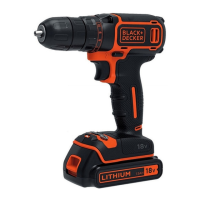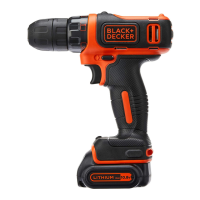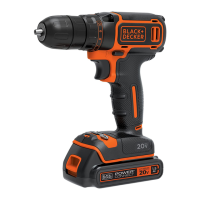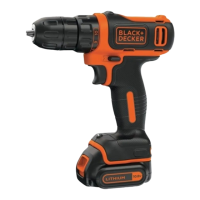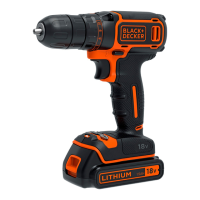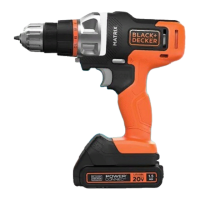5
ENGLISH
Charging Procedure (Fig. A)
WARNING: Do not use tool while it is connected to the
USB cable.
1. Plug the charger
5
into any standard 120Volt 60Hz
electricaloutlet.
2. Insert the micro USB plug
7
into the charging port
4
.
NOTE: Because this tool is equipped with a USB port,
it can be charged through USB ports. Ensure the cable
(Micro USB) and port are USB compliant.
3. Ensure the green charging LED
6
is illuminated. If the
green charging LED is not illuminated, adjust tool handle
to ensure charging contacts are touching.
4. Charging is complete when the five green charging
LEDs
6
remains continuously ON. Battery can be left
charging or USB cable can bedisconnnected.
5. Let the tool charge initially for at least 1hour. After the
initial charge, your tool should be fully charged in 1hour
from a fully discharged condition. Recharge discharged
batteries as soon as possible after use or battery life may
be greatly diminished. For longest battery life, do not
discharge batteries fully. It is recommended that the
batteries be recharged after eachuse.
Hot/Cold Delay
When the tool detects that the battery that is too hot or too
cold, it automatically starts a hot/cold delay, suspending
Important Safety Instructions for All
Integral Battery Charging
WARNING: Read all safety warnings, instructions,
and cautionary markings for the battery, charger
and product. Failure to follow the warnings and
instructions may result in electric shock, fire and/
or seriousinjury.
• The provided charger is not intended for any uses
other than charging BLACK+DECKER rechargeable
tools. Charging other types of tools may cause
their batteries to overheat and burst, resulting in
personal injury, property damage, fire, electric shock
orelectrocution.
• DO NOT expose charger to water, rain orsnow.
• Pull by the plugs rather than the cord when
disconnecting the charger. This will reduce the risk of
damage to the plugs andcord.
• Make sure that the cord is located so that it will not
be stepped on, tripped over or otherwise subjected to
damage orstress.
• When charging the tool outdoors, always provide a
drylocation.
• DO NOT use a charger with a damaged cord orplugs.
Have them replacedimmediately.
• Foreign materials of a conductive nature, such as, but
not limited to, grinding dust, metal chips, steel wool,
aluminum foil or any buildup of metallic particles
should be kept away from the charger and charging
contacts.
• Always unplug the charger from the power supply
when there is no tool attached toit.
liquids, gases or dust. Inserting or removing the plug
from the tool may ignite the dust orfumes.
• ONLY CHARGE the tool with provided charger
• DO NOT splash or immerse in water or otherliquids.
• DO NOT allow water or any liquid to entertool.
• DO NOT store or use the tool in locations where the
temperature may reach or exceed 104°F (40°C) (such
as outside sheds or metal buildings in summer). For
best life store tools in a cool, drylocation.
NOTE: Do not store the tool with the switch locked on.
Never tape the switch in the ONposition.
• DO NOT incinerate the tool even if it is severely
damaged or is completely worn out. The battery can
explode in a fire. Toxic fumes and materials are created
when lithium‑ion batteries areburned.
• If battery contents come into contact with the skin,
immediately wash area with mild soap and water. If
battery liquid gets into the eye, rinse water over the open
eye for 15minutes or until irritation ceases. If medical
attention is needed, the battery electrolyte is composed of a
mixture of liquid organic carbonates and lithiumsalts.
• Contents of opened battery cells may cause
respiratory irritation. Provide fresh air. If symptoms
persist, seek medicalattention.
• Battery liquid may be flammable if exposed to spark
orflame.
• Never attempt to open the tool for any reason. If the
tool case is cracked or damaged, do not charge. Do
not crush, drop or damage the tool. Do not use a tool or
charger that has received a sharp blow, been dropped, run
over or damaged in any way (e.g., pierced with a nail, hit
with a hammer, stepped on). Damaged tools should be
returned to the service center forrecycling.
Storage Recommendations
The best storage place is one that is cool and dry, away
from direct sunlight and excess heat or cold. Store the fully
charged tool disconnected from thecharger.
Transportation
NOTE: Integral Li‑ion tools should not be put in checked
baggage on airplanes and must be properly protected from
short circuits if they are in carry‑onbaggage.
Tool Disposal
This product uses a lithium‑ion rechargeable and recyclable
battery. When the battery no longer holds a charge, the tool
should be recycled. The tool should not be incinerated or
placed in thetrash.
The tool can be taken for disposal to an Authorized Service
Center. Some local retailers are also participating in a national
recycling program (refer to RBRC®). Call your local retailer for
details. If you bring the tool to an Authorized Service Center,
the Center will arrange to recycle the tool and its battery.
Or, contact your local municipality for proper disposal
instructions in your city/town.

